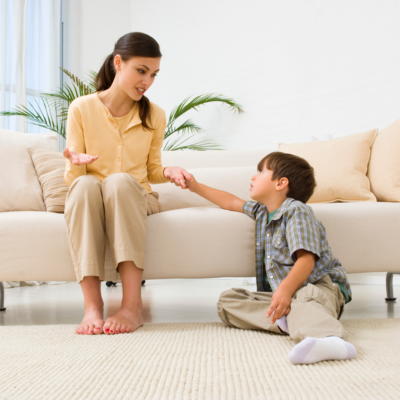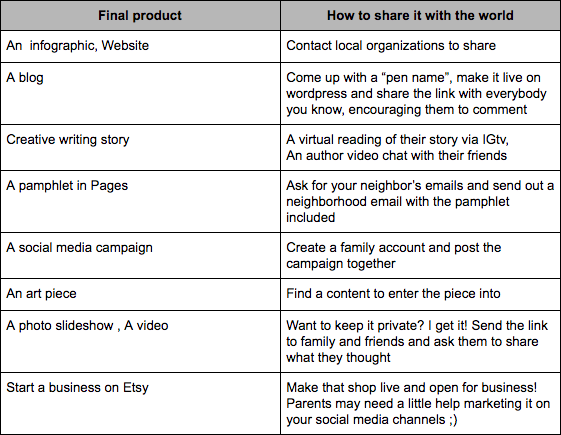PBL Lite for Parents: Making the most of COVID-19
I have really struggled to write this post for the past 2 weeks, but the question keeps coming: “Can’t people just do PBL lite?”. Part of me loves this question when it comes from my friends because it means that as parents they follow my work and like what they see and want it for their children; but the practitioner in me really struggles with the notion of a distilled version of PBL because I have built a career on designing authentic, but also rigorous project-based experiences that are grounded in standards and best practices of assessment. But if there is one thing we are all learning in this COVID-19 crisis, it’s that not much as before has stayed the same. AND that there is a real need to rethink how things have traditionally been done if we want to make it through these tough times ahead. Not to mention #realtalk alert: I still haven’t had many of my questions answered about how students are currently being assessed and provided feedback, tracked for “seat time” or adequately prepared for the academic skills of the grade ahead; which makes standards a moot point at this given moment. So here goes…I’m giving PBL lite a go for all my parent-friends… or heck, that teacher who keeps sending home worksheets and “requiring” children to be on a screen for hours on end.
Start here: Talk to your child. Ask more questions.
I know this sounds oddly simple, but our current homeschool/home-office setups don’t really allow for this. When children are asked to sit behind a screen for a time allotment that is beyond what our longitudinal research can prove is not harmful (last I heard from my pediatrician, it’s 30 minutes a day), there isn’t much time for them to conversate and just be curious. Similarly, for those of us working parents who are trying to salvage business that has just been dumped upside down, taking time out of the day to just sit and chat falls to the bottom of our to-do list. But kids and adults need time to wonder, and a good project really does start with a good question.
So ask your child: “what have you always wondered?” or “what have you always wanted to learn about and never had the chance?”
On day 1 of quarantine, here is what my kids answered : “I always wondered how those machines are able to track the speed of a pitcher” and “how do you explain how when I kick a soccer ball in a certain spot or in a certain way it changes the outcome so much?”
If the remainder of this post feels aggressive and overwhelming, just start with this first step. Something I see missing in school in general, but especially now is inquiry, which is kids asking questions. Remember when they were three and asked “why” all the time? Well that stopped because we schooled them out of it. Now is the opportunity to undo that! Just taking a break from technology and committing to having questions with your child that speaks to their interests and wonders is a great first step to PBL!
Rethink “research”
Once your child comes up with a good question then set out to answer it-depending on their age you will likely need to help them, or if you are like me you may too just be curious and enjoy the Coronavirus distraction. This could mean a simple Google search, printing up some articles (check out Newsela for this), watching some cool videos and documentaries, or it could mean rethinking traditional research entirely. A best practice of PBL is field-work, which just means using the real world to answer your questions. So think about if you have a friend who is an expert in that area- maybe your child could write some interview questions and hit them up for a call. Pull up your laptop and take a virtual field trip with Google Earth or a live webcam (the San DIego Zoo has an incredible one!); Or maybe even a quick road trip (of course honoring the “stay home order” and not leaving your car-but hey new scenery is welcome at this point AND this isn’t technically breaking any rules) to view a particular place and make some observations together.
Show what you know
A big part of PBL is creating a final product that applies the content and skills a student learned to a new context and also showcases this knowledge. So brainstorm with your child some ways that they could show what they learned from researching to answer their question, so that others can learn from them (more on that next). Here are some ideas:
An infographic -using Canva or Piktochart preloaded templates
A blog, creative writing story or website
A pamphlet in Pages
A social media campaign
An art piece
A video
A photo slideshow
Start a business on Etsy
Teach time management
Parents, you got this step! This is simply taking what your child wants to create and breaking it down into smaller steps and checkpoints for you to be sure they are on the right track. This could look like an outline, a brianstorm, a draft, or a sketch. The idea here is that they are thinking through their plans and managing their time accordingly. THis also may be a cool moment for you to share with them how you manage projects in your industry. I recommend writing out the steps together and allocating when they will work on each part. In our house that’s just me drawing out a week schedule (table) on a piece of lined paper-nothing fancy. You can also use this “passion project proposal” that I created.
Share with the world
Finally, in PBL there is always an authentic audience who could benefit from hearing what students learned about in their project (beyond just their class- although they could likely benefit too!). Have you seen the social media campaign from Nike:” Play for the world”? Well this part of PBL is a lot like that, except it’s “Learn for the world”: Stay home but keep doing what you are passionate about! While this step is a little tricky under home quarantine, with the help of technology it’s totally possible! Here are some ideas with the final products listed above:
Again, if you are a working parent this may feel like more work for you. However, what I’m finding is that homeschool in general is more work for me! SO I would way rather spend the time working on something that feels meaningful for my child than plopping them in front of a screen or printing out yet another worksheet, watching the engagement and passion drain from them by the day. My hope is that by offering up “PBL lite” maybe you can learn along with your kids and you both can find some passion in learning together. You don’t need to be a teacher to do this version of PBL-this is just life skills and curiosity, within the context that you live in every day-you got this! Let me know how it goes and tag #craftEDcares!
Need more parent resources? I got you covered!
- Check out what’s under “parents” HERE.
- A more structured project the sports questions my own kids came up with: HERE
- A built out project HERE (it’s more like PBL SUPER UNLEADED, but hey give it a go!)
If you are looking for something to send your teachers, this is a great post by a well-respected leader in education that can help make a case for less screen time and more time available for PBL lite at home 😉


